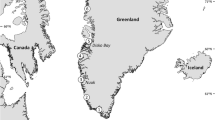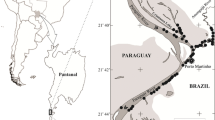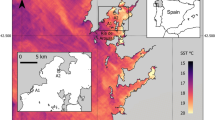Abstract
Production of wedge clam (Donax trunculus) has experienced a widespread decrease. Environmental conditions have been postulated as an important agent though the effects on reproduction are poorly understood. We here review the reproductive cycle and evaluate the influence of environmental conditions in Galicia (NW Iberian coast). We further contrast the variability of reproductive traits across the distribution range. Reproductive individuals dominate size classes between 20 and 30 mm, and spawning spans from April to July with a subsequent inactive period from September onwards. Length at first maturity (L50) was established at 19 mm. Oocyte size was unrelated to shell size or gonad occupancy, and realized fecundity averaged 8 × 105 eggs per female. Environmental conditions had significant effects on the gonadosomatic index and flesh yield which were lower in less productive waters. Furthermore, the interannual proportion of fully mature individuals during the spawning period maximized at high and low levels of coastal upwelling and continental runoff, respectively. Across the distribution range, water temperature and chlorophyll concentration defined the geographical differences on reproductive traits with lower L50 and longer spawning period occurring in warmer waters and the central month of spawning taking place earlier in the year in more productive waters.









Similar content being viewed by others
References
Álvarez-Salgado, X. A., S. Beloso, I. Joint, E. Nogueira, L. Chou, F. Pérez, S. Groom, J. M. Cabanas, A. Rees & M. Elskens, 2002. New production of the NW Iberian shelf during the upwelling season over the period 1982–1999. Deep Sea Research I 49: 1725–1739.
Álvarez-Salgado, X. A., U. Labarta, V. Vinseiro & M. J. Fernández-Reiriz, 2017. Environmental drivers of mussels flesh yield in a coastal upwelling system. Ecological Indicators 79: 323–329.
Ansell, A. & A. Bodoy, 1979. Comparison of events in the seasonal cycle for Donax vittatus and D. trunculus in European waters. In Naylor, E. & R. G. Hartnoll (eds), Cyclic phenomena in marine plants and animals. Pergamon Press, Oxford: 191–198.
Ansell, A. & F. Lagardère, 1980. Observations on the biology of Donax trunculus and D. vittatus at Ille d’Oléron (French Atlantic coast). Marine Biology 57: 287–300.
Arístegui, J., E. D. Barton, X. A. Álvarez-Salgado, A. M. P. Santos, F. G. Figueiras, S. Kifani, S. Hernández-León, E. Mason, E. Machú & H. Demarcq, 2009. Sub-regional ecosystem variability in the Canary Current upwelling. Progress in Oceanography 83: 33–48.
Asch, R. G., 2015. Climate change and decadal shifts in the phenology of larval fishes in the California Current ecosystem. Proceedings of the National Academy of Sciences of the USA 112: E4065–E4074.
Bayed, A., 1990. Reproduction of Donax trunculus on the Moroccan Atlantic coast. Cahiers de Biologie Marine 31: 159–169.
Bidegain, G., M. Sestelo, J. Roca-Pardiñas & J. A. Juanes, 2013. Estimating a new suitable catch size for two clam species: implications for shellfishery management. Ocean Coastal Management 71: 52–63.
Bode, A., M. Álvarez, M. Ruíz-Villarreal & M. M. Varela, 2019. Changes in phytoplankton production and upwelling intensity off A Coruña (NW Spain) for the last 28 years. Ocean Dynamics 69: 861–873.
Boussoufa, D., N. Ghazali, I. Rabeh, N. Soudani, J. Navarro & M. El Cafis, 2015. Reproductive cycle and gonad development of the commercial clam Donax trunculus from the Bay of Tunis (Northern Tunisia, South Mediterranean coast): effects of environmental variability. Cahiers de Biologie Marine 56: 369–380.
Cabrero, A., G. González-Nuevo, J. Gago & J. M. Cabanas, 2019. Study of sardine (Sardina pilchardus) regime shifts in the Iberian Atlantic shelf waters. Fisheries Oceanography 28: 305–316.
Cerdeira-Arias, J. D., J. Otero, E. Barceló, et al., 2018. Hydrography of shellfish harvesting areas in the western Cantabrian coast (Rías Altas, NW Iberian Peninsula). Regional Studies in Marine Science 22: 125–135.
Cerdeira-Arias, J. D., J. Otero, X. A. Álvarez-Salgado, A. Mena & M. A. Nombela, 2021. Multivariate substrate characterization: The case of shellfish harvesting areas in the Rías Altas (north-west Iberian Peninsula). Sedimentology 68: 697–712.
Cerviño, A., 2011. Ciclo reproductivo, cultivo en criadero y en el medio natural de la almeja babosa Venerupis pullastra (Montagu, 1803). PhD. Thesis, University of Santiago de Compostela, Spain. (In Spanish).
Costa, C., M. Bianchini, P. Ceccarelli, P. Orecchia, E. Rambaldi & R. Volterra, 1987. Indagine sui molluschi bivalvi di interese commerciale (telline, cannolicchi e vongole) delle coste della Toscana, del Lazio e della Campania, 1985–1987. Quad Ist Idrobiol Acquacolt G. Brunelli 7:58 pp.
Cribari-Neto, F. & A. Zeileis, 2010. Beta regression in R. Journal of Statistical Software 34: 2.
Darriba, S., F. San Juan & A. Guerra, 2004. Reproductive cycle of the razor clam Ensis arcuatus (Jeffreys, 1865) in northwest Spain and its relation to environmental conditions. Journal of Experimental Marine Biology and Ecology 311: 101–115.
Davidson, A. C. & D. V. Hinkley, 1997. Bootstrap Methods and Their Application. Cambridge University Press, Cambridge.
de la Huz, R., M. Lastra & J. López, 2002. The influence of sediment grain size on burrowing, growth and metabolism of Donax trunculus L. (Bivalvia: Donacidae). Journal of Sea Research 47: 85–95.
Delgado, M. & A. Pérez-Camacho, 2007. Comparative study of gonadal development of Ruditapes philippinarum (Adams and Reeve) and Ruditapes decussatus (L.) (Mollusca: Bivalvia): influence of temperature. Scientia Marina 71: 471–484.
Delgado, M. & L. Silva, 2018. Timing variations and effects of size on the reproductive output of the wedge clam Donax trunculus (L. 1758) in the littoral of Huelva (SW Spain). Journal of the Marine Biological Association of the UK 98: 341–350.
Des Roches, S., D. Post, N. Turley, J. Bailey, A. Hendry, M. Kinnison, J. Schweitzer & E. Palkovacs, 2018. The ecological importance of intraspecific variation. Nature Ecology and Evolution 2: 57–64.
Deval, M. C., 2009. Growth and reproduction of the wedge clam (Donax trunculus) in the Sea of Marmara, Turkey. Journal of Applied Ichthyology 25: 551–558.
Drinkwater, K. F., 2000. Changes in ocean climate and its general effect on fisheries: examples from the Northwest Atlantic. In Mills, D. (ed), The OCEAN Life of Atlantic Salmon-Environmental and Biological Factors Influencing Survival. Fishing News Books, Oxford: 116–136.
Frangoudes, K., B. Marugán-Pintos & J. J. Pascual-Fernández, 2008. From open-access to co-governance and conservation: the case of women shellfish collectors in Galicia (Spain). Marine Policy 32: 223–232.
Fuentes-Santos, I., U. Labarta, K. Arranz & M. J. Fernández-Reiriz, 2017. From classical to nonparametric growth models: towards comprehensive modelling of mussel growth patterns. Marine Environmental Research 127: 41–48.
Gaspar, M. B., 1996. Bivalves do litoral oceânico algarvio. Aspectos sa biologia, ecologia e da pescaria dos mananciais de interesse económico: aplicaçao à gestao dos recursos. PhD Thesis, University of Algarve, Portugal. (In Portuguese).
Gaspar, M., R. Ferreira & C. Monteiro, 1999. Growth and reproductive cycle of Donax trunculus L., (Mollusca: Bivalvia) off Faro, southern Portugal. Fisheries Research 41: 309–316.
Gaspar, M. B., L. M. Chícharo, P. Vasconcelos, A. García, A. R. Santos & C. C. Monteiro, 2002. Depth segregation phenomenon in Donax trunculus (Bivalvia: Donacidae) populations of the Algarve coast (southern Portugal). Scientia Marina 66: 111–121.
González-Nuevo, G., J. Gago & J. M. Cabanas, 2014. Upwelling index: a powerful tool for marine research in the NW Iberian upwelling system. Journal of Operational Oceanography 7: 45–55.
Gosling, E., 2003. Bivalve Mollusks: Biology, Ecology and Culture. Blackwell Science, Hoboken.
Hafsaoui, I., R. Bouaziz, B. Draredja & H. Beldi, 2016. Reproduction of Donax trunculus (Mollusca, Bivalvia) in the gulf of Annaba (Northeast Algeria). Advances in Environmental Biology 10: 82–95.
Harper, S., M. Adshade, V. W. Y. Lam, D. Pauly & U. R. Sumaila, 2020. Valuing invisible catches: estimating the global contribution by women to small-scale marine capture fisheries production. PLoS ONE 15: e0228912.
Hutchings, J. A. & R. A. Myers, 1994. Timing of cod reproduction: interannual variability and the influence of temperature. Marine Ecology Progress Series 108: 21–31.
Juncal, et al., 2005. Los recursos marinos de Galicia: georreferenciación y cartografiado de los bancos marisqueros de Galicia. Evaluación del potencial marisquero. Xunta de Galicia, Santiago de Compostela. (In Spanish).
Keith, S. A., J. A. Maynard, A. J. Edwards, J. R. Guest, A. G. Bauman, R. van Hooidonk, S. F. Heron, M. L. Berumen, J. Bouwmeester, S. Piromvaragorn, C. Rahbek & A. H. Baird, 2016. Coral mass spawning predicted by rapid seasonal rise in ocean temperature. Proceedings of the Royal Society of London B 283: 2016001.
Lamine, I., A. A. Alla, M. B. Hadad, H. E. Habouz, M. Nadir & A. Moukrim, 2020. Population dynamics of Donax trunculus on the sandy beach of Taghazout (southern Morocco). Regional Studies of Marine Science 33: 100912.
Louzán, A., 2015. Desarrollo del cultivo integral de la coquina Donax trunculus (Linnaeus, 1758). Ciclo reproductivo, cultivo en criadero y en el medio natural. PhD. Thesis, University of Santiago de Compostela, Santiago de Compostela, Spain. (In Spanish).
Lowerre-Barbieri, S. K., K. Ganias, F. Saborido-Rey, H. Murua & J. R. Hunter, 2011. Reproductive timing in marine fishes: variability, temporal scales, and methods. Marine Coastal Fisheries: Dynamics, Management and Ecosystem Science 3: 71–91.
Macho, G., I. Naya, J. Freire, S. Villasante & J. Molares, 2013. The key role of the Barefoot Fisheries Advisors in the co-managed TURF system of Galicia (NW Spain). Ambio 42: 1057–1069.
Macho, G., S. A. Woodin, D. S. Wethey & E. Vázquez, 2016. Impacts of sublethal and lethal high temperatures on clams exploited in European fisheries. Journal of Shellfish Research 35: 405–419.
Maritorena, S., O. H. F. d’Andon, A. Mangin & D. Siegel, 2010. Merged satellite color data using a bio-optical model: characteristics, benefits and issues. Remote Sensing Environment 114: 1791–1804.
Martínez, D., M. E. Rodríguez, R. Arnáiz, J. L. Alonso de Landa, J. M. Camiño, L. M. Álvarez, J. M. Loureiro & M. F. López, 1993. Ciclo reproductor de coquina, Donax trunculus, relaciones con su contenido en proteínas, glucógeno, lípidos y ácidos grasos poliinsaturados. Actas del IV Congreso Nacional de Acuicultura 347–352. (In Spanish).
Martínez, D., S. Nóvoa, J. Ojea & E. Rodríguez, 2003. Talla de primera maduración sexual de la coquina, Donax trunculus (Linné, 1758) en un banco natural de la Ría del Barquero (NO Galicia). Actas del IX Congreso Nacional de Acuicultura 215–217. (In Spanish).
Martínez-Castro, C. & E. Vázquez, 2012. Reproductive cycle of the cockle Cerastoderma edule (Linnaeus 1758) in the Ría de Vigo (Galicia, northwest Spain). Journal of Shellfish Research 31: 757–767.
Martínez-Pita, I. & O. Moreno, 2019. Improving bivalve fishery management: the development of a tool to forecast bivalve reproductive season based on environmental data from satellite remote sensing observations. Fisheries Oceanography 28: 698–707.
McCullagh, P. & J. A. Nelder, 1989. Generalized Linear Models. Chapman & Hall/CRC Press, Boca Raton.
Méndez, G. & F. Vilas, 2005. Geological antecedents of the Rías Baixas (Galicia, northwest Iberian Peninsula). Journal of Marine Systems 54: 195–207.
Mouëza, M. & L. Frenkiel-Renault, 1973. Contribution a l’étude de la biologie de Donax trunculus L. (Mollusques lamelibranches) dans L’Algérois: La reproduction. Cahiers de Biologie Marine 14: 261–283.
Neuheimer, A. B. & B. R. MacKenzie, 2014. Explaining life history variation in a changing climate across a species’ range. Ecology 95: 3364–3375.
Neuheimer, A. B. & C. T. Taggart, 2010. Can changes in length-at-age and maturation timing in Scotian Shelf haddock (Melanogrammus aeglefinus) be explained by fishing? Canadian Journal of Fisheries and Aquatic Sciences 67: 854–865.
Neurberger-Cywiak, L., Y. Achituv & L. Mizrahi, 1990. The ecology of Donax trunculus Linnaeus and Donax semistriatus Poli from the Mediterranean coast of Israel. Journal of Experimental Marine Biology and Ecology 134: 203–220.
Nombela, M. A., P. Diz, E. Couto & G. Martínez, 2017. Textural characteristics might influence Donax trunculus shellfishing banks exploitability. Thalassas 33: 87–93.
Nóvoa, S., J. Ojea, S. Castilla, E. Grangel & D. Martínez, 2018. Estado reproductivo de una población de coquina de la playa de Vilarrube (Galicia). Foro dos Recursos Mariños e da Acuicultura das Rías Galegas 20: 279–285. (In Spanish).
Ojea, J., 2013. Estudio del desarrollo gametogénico de la almeja fina, Ruditapes decussatus (Linné, 1758) en el medio natural y optimización de las condiciones del acondicionamiento en criadero. PhD. Thesis, University of Santiago de Compostela, Spain. (In Spanish).
Olive, P. J. W., 1992. The adaptive significance of seasonal reproduction in marine invertebrates: the importance of distinguishing between models. Invertebrate Reproductive Development 22: 165–174.
Otero, J., X. A. Álvarez-Salgado, A. F. González, M. Gilcoto & A. Guerra, 2009. High-frequency coastal upwelling events influence Octopus vulgaris larval dynamics on the NW Iberian shelf. Marine Ecology Progress Series 386: 123–132.
Parada, J. M., J. Molares & X. Otero, 2012. Multispecies mortality patterns of commercial bivalves in relation to estuarine salinity fluctuation. Estuaries and Coasts 35: 132–142.
Pawiro, S., 2010. Bivalves: global production and trade trends. In Rees, G., et al. (eds), Safe Management of Shellfish and Harvest Waters. WHO and Iwa Publishing, London: 11–19.
Pellowe, K. E. & H. M. Leslie, 2020. Size-selective fishing leads to trade-offs between fishery productivity and reproductive capacity. Ecosphere 11: e03071.
Peteiro, L. G., U. Labarta, M. J. Fernández-Reiriz, X. A. Álvarez-Salgado, R. Filgueira & S. Piedracoba, 2011. Influence of intermittent-upwelling on Mytilus galloprovincialis patterns in the Ría de Ares-Betanzos. Marine Ecology Progress Series 443: 111–127.
Philippart, C. J. M., J. D. L. van Bleijswijk, J. C. Kromkamp, A. F. Zuur & P. M. J. Herman, 2014. Reproductive phenology of coastal marine bivalves in a seasonal environment. Journal of Plankton Research 36: 1512–1527.
Pörtner, H., C. Bock, R. Knust, G. Lanning, M. Lucassen, F. Mark & F. Sartoris, 2008. Cod and climate in a latitudinal cline: physiological analyses of climate effects in marine fishes. Climate Research 37: 253–270.
Ramón, M., 1993. Estudio de las poblaciones de Chamelea gallina (Linnaeus, 1758) y Donax trunculus (Linnaeus, 1758) (Mollusca: Bivalvia) en el Golfo de Valencia (Mediterráneo Occidental). PhD. Thesis, University of Barcelona, Spain. (In Spanish).
R Core Team, 2020. R: A language and environment for statistical computing. In: R Foundation for Statistical Computing, Vienna, Austria. ISBN 3-900051-07-0, http://R-project.org
Reitzel, A. M., B. G. Miner & L. R. McEdward, 2004. Relationships between spawning date and larval development time for benthic marine invertebrates: a modeling approach. Marine Ecology Progress Series 280: 13–23.
Reynolds, R. W., T. M. Smith, C. Liu, D. B. Chelton, K. S. Casey & M. G. Schlax, 2007. Daily high-resolution-blended analyses for sea surface temperature. Journal of Climate 20: 5473–5496.
Ríos, P., 2001. Bancos marisqueros de moluscos bivalvos de sustratos blandos, explotados en las costas de Galicia. MsC. Thesis, University of Santiago de Compostela, Spain. (In Spanish).
Riveiro, I., C. Guisande, I. Maneiro & A. R. Vergara, 2004. Parental effects in the European sardine Sardina pilchardus. Marine Ecology Progress Series 274: 225–234.
Surís-Regueiro, J. C. & J. L. Santiago, 2014. Characterization of fisheries dependence in Galicia (Spain). Marine Policy 47: 99–109.
Tirado, C. & C. Salas, 1998. Reproduction and fecundity of Donax trunculus L., 1758 (Bivalvia: Donacidae) in the littoral of Málaga (Southern Spain). Journal of Shellfish Research 17: 169–176.
Tirado, C., J. Rueda & C. Salas, 2011. Reproduction of Donax trunculus in the littoral of Huelva (southern Atlantic Spain): is there any difference with the Mediterranean population from the Andalusian coast? Iberus 29: 47–57. (In Spanish).
Tlili, S., I. Métais, N. Ayache, H. Boussetta & C. Mouneyrac, 2011. Is the reproduction of Donax trunculus affected by their sites of origin contrasted by their level of contamination? Chemosphere 84: 1362–1370.
Valle, P. L., 2005. Donax trunculus (Bivalvia: Donacidae) as a biological indicator of coastal dynamic and sedimentary balance. PhD. Thesis, University of “La Sapienza”, Roma, Italy. (In Italian).
Valle, P. L., L. Nicoletti, M. G. Finoia & G. D. Ardizzone, 2011. Donax trunculus (Bivalvia: Donacidae) as a potential biological indicator of grain-size variations in beach sediment. Ecological Indicators 11: 1426–1436.
Veloy, C., 2018. Reproductive aspects of Donax trunculus (Linnaeus, 1758) in the shellfishing ground of Vilarrube. Implications in fisheries management. MsC. Thesis, University of A Coruña, Spain. (In Spanish).
Wilson, J. & R. Seed, 1974. Reproduction in Mytilus edulis L. (Mollusca: Bivalvia) in Carlingford Lough. Northern Ireland. Irish Fisheries Investigation B 15: 1–30.
Wood, S. N., 2006. Generalized Additive Models: An Introduction with R. Chapman & Hall/CRC Press, Boca Raton.
Zeichen, M. M., S. Agnesi, A. Mariani, A. Maccaroni & G. Ardizzone, 2002. Biology and population dynamics of Donax trunculus L. (Bivalvia: Donacidae) in the South Adriatic coast (Italy). Estuarine, Coastal and Shelf Science 54: 971–982.
Acknowledgements
This study has been funded by Consellería do Mar (Xunta de Galicia) through the projects PGIDIT-CIMA 13/08 and CIMA 16/06. X.A.A.S. acknowledges the support of the EU H2020 project ClimeFish (EU 677039).
Author information
Authors and Affiliations
Contributions
DMP and JO designed the project. DMP, AL, JO and SNV carried out the field and laboratory work. JO and XAAS analyzed the data. JO wrote the manuscript and DMP, SNV and XAAS helped with the interpretation of general results.
Corresponding author
Ethics declarations
Conflict of interest
The authors declare that they have no conflict of interest.
Additional information
Handling editor: Manuel Lopes-Lima
Publisher's Note
Springer Nature remains neutral with regard to jurisdictional claims in published maps and institutional affiliations.
Supplementary Information
Below is the link to the electronic supplementary material.
Rights and permissions
About this article
Cite this article
Patiño, D.M., Otero, J., Louzán, A. et al. Wedge clam (Donax trunculus Linnaeus, 1758) reproduction: reproductive traits and environmental influence in the NW Iberian coast and contrast across Atlantic and Mediterranean waters. Hydrobiologia 848, 1347–1366 (2021). https://doi.org/10.1007/s10750-021-04532-x
Received:
Revised:
Accepted:
Published:
Issue Date:
DOI: https://doi.org/10.1007/s10750-021-04532-x




